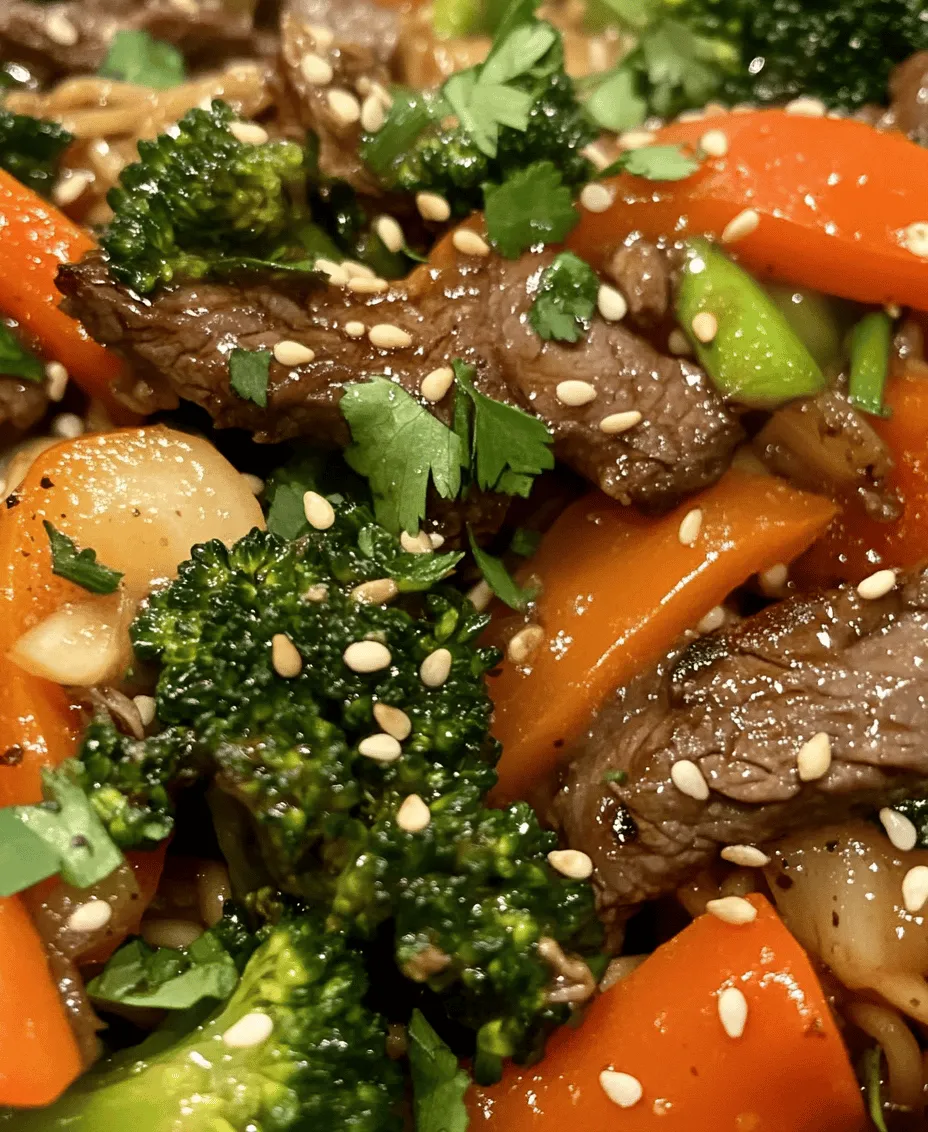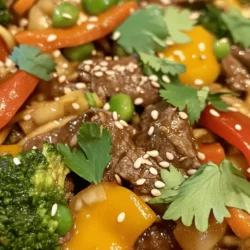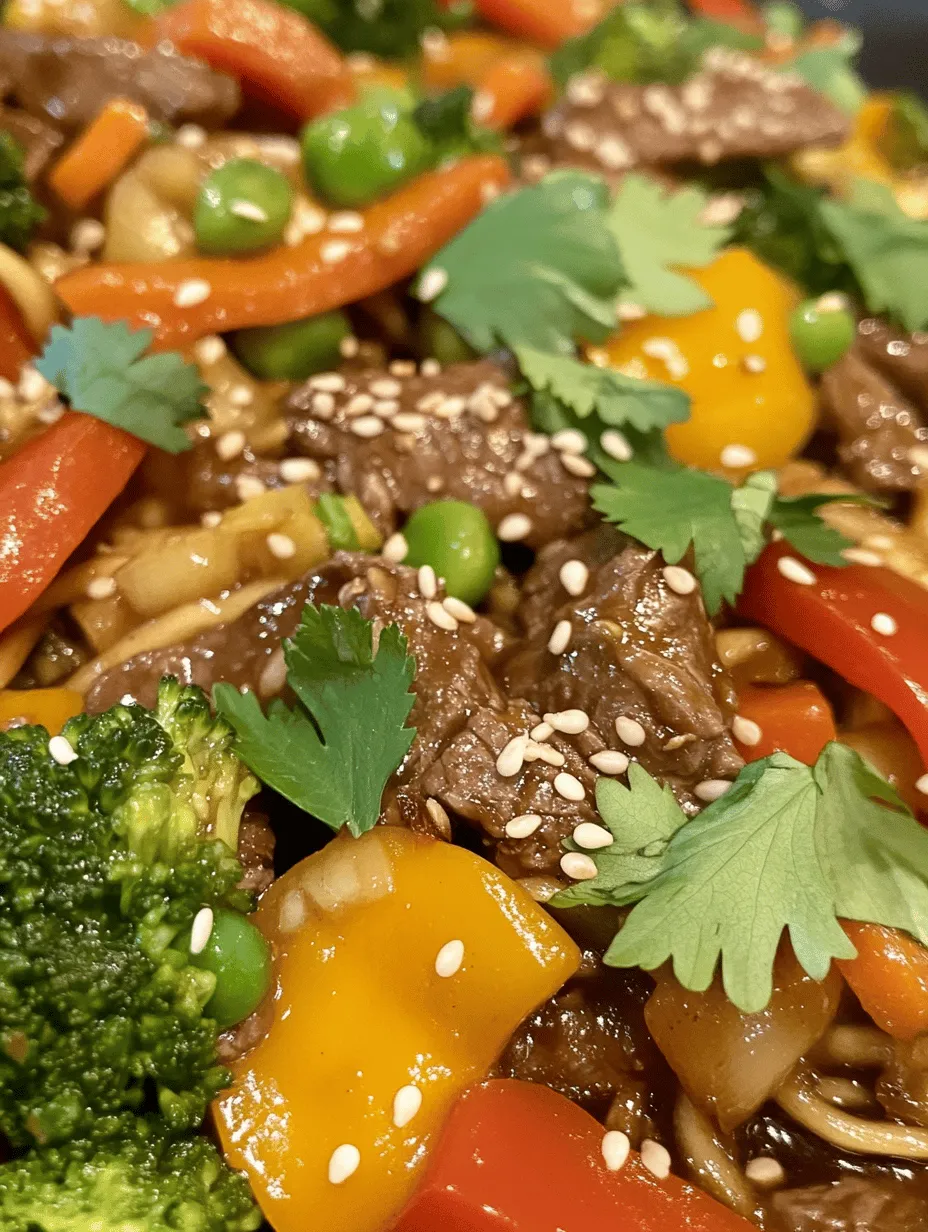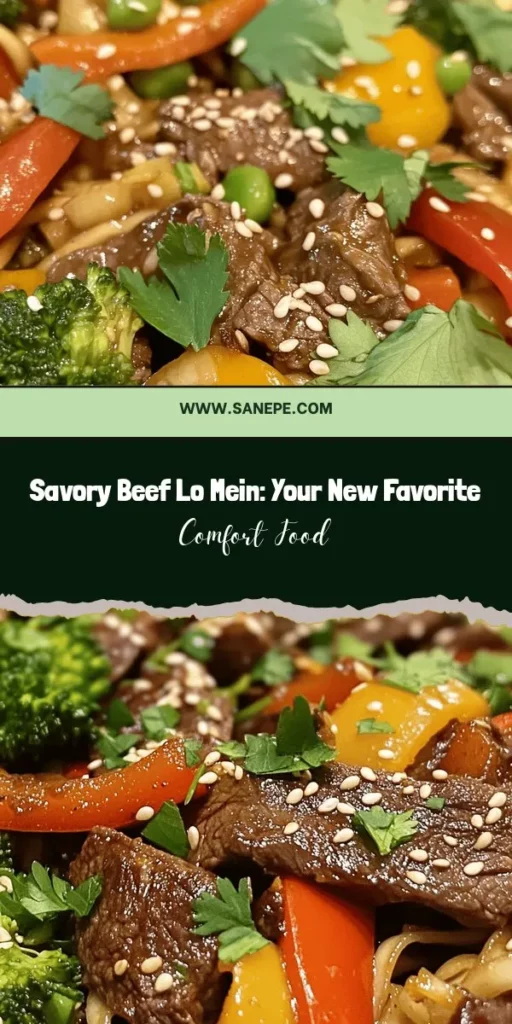Introduction
If you’re searching for a dish that embodies comfort, flavor, and a touch of culinary adventure, look no further than Savory Beef Lo Mein. This beloved dish is more than just a meal; it’s a celebration of flavors that have found their way into homes across the globe. Originating from Chinese cuisine, Lo Mein has gained immense popularity, not just in Asian restaurants but also in home kitchens, where families come together to enjoy a hearty and satisfying meal.
Lo Mein, which translates to “stirred noodles,” has roots that date back centuries, evolving as it traveled and adapted to various cultures. While traditional recipes often feature a medley of ingredients, the star of this particular recipe is undoubtedly the beef. Its rich, tender texture combined with the savory flavors of soy sauce and aromatic vegetables creates a dish that feels like a warm hug on a plate.
In an age where takeout seems like the easiest option, there’s something incredibly rewarding about cooking from scratch. Homemade meals not only allow you to control the ingredients, ensuring a healthy and nutritious dish, but they also provide an opportunity for creativity and personalization. With Savory Beef Lo Mein, you can tailor the flavors to suit your palate and create a dish that’s not only delicious but deeply satisfying.
Understanding the Ingredients
To create the perfect Savory Beef Lo Mein, a few key ingredients come together to form a harmonious blend of flavor and texture. Each component plays a significant role, contributing to the overall taste and nutritional value of the dish.
Essential Components of Savory Beef Lo Mein
1. Noodles: The foundation of any Lo Mein dish, noodles are vital for texture and substance. While you can use different types of noodles, the classic choice is lo mein noodles, which are thick, chewy, and perfect for holding onto sauces. Egg noodles can also be used as an alternative, offering a slightly different texture and flavor.
2. Flank Steak: This cut of beef is ideal for stir-frying due to its lean nature and rich flavor. Flank steak is tender when cooked correctly and absorbs marinades beautifully, making it a popular choice in many Asian dishes. Its ability to be sliced thinly adds to the overall experience of eating Lo Mein, allowing for a perfect bite with every forkful.
3. Sauces: Soy sauce, oyster sauce, and sesame oil are the heart of Asian cooking, and they play a crucial role in this recipe. Soy sauce provides the foundational umami flavor, while oyster sauce adds a depth of sweetness and complexity. Sesame oil, with its nutty aroma, enhances the overall taste profile, giving the dish a fragrant finish.
4. Fresh Vegetables: A colorful array of vegetables not only boosts the nutritional value of your Lo Mein but also adds a delightful crunch and freshness to the dish. Broccoli, bell peppers, and carrots are excellent choices. Broccoli is rich in vitamins and adds a satisfying crunch, bell peppers provide sweetness and color, and carrots lend an earthy flavor and additional nutrients.
In-Depth Look at Main Ingredients
Egg Noodles vs. Lo Mein Noodles
While both types of noodles can work well in this dish, it’s essential to understand their differences. Lo mein noodles are typically made from wheat flour and water, resulting in a chewy texture that holds up to stir-frying. On the other hand, egg noodles incorporate eggs into the dough, making them richer and slightly denser. When choosing between the two, consider the texture you prefer; lo mein noodles are perfect for a traditional approach, while egg noodles can offer a unique twist.
Flank Steak: The Best Choice
Flank steak is celebrated for its robust flavor and tenderness when cooked properly. When preparing Lo Mein, slicing the flank steak against the grain is crucial to ensure tenderness. This cut is also relatively lean, making it a healthier option without compromising on taste. For optimal results, marinate the flank steak to enhance its flavor and tenderness further, which we will discuss in the following sections.
The Role of Sauces in Asian Cooking
The combination of soy sauce, oyster sauce, and sesame oil creates a flavor profile that is both savory and satisfying. Soy sauce is a staple in many Asian dishes, providing saltiness and depth. Oyster sauce, made from oyster extracts, adds a sweet and slightly briny flavor that complements the beef beautifully. Sesame oil, used sparingly, imparts a distinct flavor that ties the dish together, making it aromatic and inviting.
Fresh Vegetables: Enhancing Nutrition and Flavor
Incorporating fresh vegetables into your Lo Mein not only elevates the taste but also boosts the dish’s health benefits.
– Broccoli: Packed with vitamins C and K, broccoli is known for its antioxidant properties and can aid in digestion.
– Bell Peppers: Rich in vitamins A and C, bell peppers add sweetness and vibrancy, making the dish visually appealing as well.
– Carrots: A great source of beta-carotene, carrots contribute to eye health and add a subtle sweetness to the dish.
These vegetables not only provide essential nutrients but also enhance the overall texture and flavor of your Savory Beef Lo Mein, making it a well-rounded meal.
Preparation Techniques for a Perfect Lo Mein
Creating the ultimate Savory Beef Lo Mein involves a few essential preparation techniques that will elevate your dish from good to extraordinary. Mastering the cooking process is key, and we will break it down into three main steps: cooking the noodles, marinating the beef, and stir-frying the ingredients.
Cooking the Noodles
The first step in preparing your Savory Beef Lo Mein is cooking the noodles. Here’s a simple step-by-step guide to ensure you achieve the perfect noodle texture:
1. Boil Water: Fill a large pot with water and bring it to a rolling boil. Adding a pinch of salt can enhance the flavor of the noodles.
2. Add Noodles: Once the water is boiling, add your lo mein or egg noodles. Stir gently to ensure they don’t stick together.
3. Cook According to Package Instructions: Follow the cooking time on the package, typically around 3-5 minutes for fresh noodles. For dried noodles, it may take slightly longer.
4. Check for Doneness: Taste a noodle to check for doneness; they should be cooked but firm (al dente) since they will continue to cook during stir-frying.
5. Drain and Rinse: Once cooked, drain the noodles in a colander and rinse them under cold water. This stops the cooking process and helps prevent sticking.
6. Toss with Oil: To further prevent sticking, toss the noodles with a teaspoon of sesame oil or vegetable oil before setting them aside.
Marinating the Beef
Marination is a crucial step in building flavor in your Savory Beef Lo Mein. Here’s how to prepare your flank steak for maximum taste:
1. Slice the Flank Steak: Begin by slicing the flank steak against the grain into thin strips. This will ensure tenderness in each bite.
2. Prepare the Marinade: In a bowl, combine soy sauce, oyster sauce, a dash of sesame oil, and minced garlic. This mixture will impart flavor and tenderness to the beef.
3. Marinate: Add the sliced beef to the marinade, ensuring each piece is well coated. Cover the bowl with plastic wrap and let it marinate for at least 30 minutes. For deeper flavor, marinate for up to 2 hours in the refrigerator.
4. Let it Rest: After marination, let the beef sit at room temperature for about 10 minutes before cooking. This helps in even cooking and enhances the final texture.
Stir-Frying: The Heart of Lo Mein
Now that you have your noodles and beef prepped, it’s time to bring everything together through the art of stir-frying. This technique is what makes Lo Mein truly special, allowing the ingredients to meld together beautifully while retaining their individual textures and flavors.
In the next section, we will delve into the stir-frying process, detailing how to achieve that perfect balance of flavors and textures in your Savory Beef Lo Mein Delight. Stay tuned to discover the secrets to crafting this ultimate comfort meal that’s sure to impress your family and friends.

Essential Tools for Stir-Frying: Wok vs. Skillet
When it comes to preparing Savory Beef Lo Mein, the right tools can make a significant difference in the outcome of your dish. The two most popular options for stir-frying are a traditional wok and a skillet.
Wok
A wok is designed with high, sloping sides that allow for rapid heating and even cooking. The shape of the wok promotes a quick stir-fry, allowing you to toss ingredients easily without spilling. The high sides also help retain heat, which is essential for achieving that coveted sear on the beef and maintaining the crispness of your vegetables.
Skillet
A skillet, particularly a heavy-bottomed one, can also work well for stir-frying. While it doesn’t offer the same high sides as a wok, a skillet can be beneficial for those who may not have a wok on hand. A cast iron or non-stick skillet can provide great heat retention and make it easier to manage smaller quantities of ingredients.
For the best results, consider using a wok if you have one available. The choice between a wok and a skillet will depend on your cooking style and the tools you have at your disposal.
Step-by-Step Instructions for Stir-Frying Vegetables
Stir-frying vegetables is an art, and following these steps will ensure they remain vibrant and delicious in your Savory Beef Lo Mein.
1. Prep the Vegetables: Start by washing and cutting your vegetables into uniform pieces. This ensures even cooking. Common choices for Lo Mein include bell peppers, carrots, broccoli, and snap peas.
2. Heat the Pan: Preheat your wok or skillet over high heat. Add a tablespoon of oil (canola or peanut oil works well) and allow it to shimmer before adding your vegetables.
3. Stir-Fry: Add the hardest vegetables first (like carrots and broccoli) and stir-fry for about 1-2 minutes. Then, add the softer vegetables (like bell peppers and snap peas) and continue to stir-fry for an additional 2-3 minutes.
4. Seasoning: A pinch of salt and a dash of soy sauce at this point can enhance the flavor. Make sure to keep the vegetables moving in the pan to prevent burning and to keep their color bright.
Techniques to Maintain Crispness and Color
To achieve that perfect crunch and vibrant color in your vegetables, follow these techniques:
– High Heat: Cooking on high heat is crucial for stir-frying. It quickly cooks the outer layer of the vegetable while keeping the inside crisp.
– Don’t Overcrowd: If cooking in batches, avoid overcrowding the pan. Too many vegetables at once will lower the temperature and lead to steaming instead of frying.
– Quick Cooking Time: Aim for a total stir-fry time of 3-5 minutes for the vegetables. They should be tender but still crisp and colorful.
Cooking the Beef
The beef is the star of Savory Beef Lo Mein, and cooking it properly is essential for achieving a satisfying dish.
1. Choose the Right Cut: Flank steak or sirloin is ideal for this recipe. Slice the beef thinly against the grain to maximize tenderness.
2. Marinate the Beef: Marinate your sliced beef in a mixture of soy sauce, cornstarch, and a splash of sesame oil for about 15-30 minutes. This not only adds flavor but also helps tenderize the meat.
3. Sear the Beef: Heat your wok or skillet over high heat and add a tablespoon of oil. Once the oil is hot, add the marinated beef in a single layer. Sear the beef without stirring for about 1-2 minutes to develop a nice crust.
4. Stir and Cook: After the initial sear, stir-fry the beef for another 2-3 minutes until it is just cooked through. Be careful not to overcook, as this can lead to tough meat.
Perfecting the Sear and Ensuring Tenderness
To achieve a perfect sear on your beef while ensuring it remains tender, keep these tips in mind:
– Don’t Move Too Much: Allow the beef to sear properly by not stirring it immediately after adding it to the pan. This helps develop a flavorful crust.
– Temperature Control: Ensure your pan is sufficiently hot before adding the beef. If necessary, cook in batches to maintain high heat.
– Rest the Meat: After cooking, let the beef rest for a few minutes before combining it with the vegetables and noodles. This allows juices to redistribute for maximum tenderness.
Combining Ingredients
Once your beef and vegetables are cooked, it’s time to bring everything together:
1. Add Noodles: Boil your lo mein noodles according to package instructions. Drain and set aside. If using dried noodles, soak them in hot water until softened.
2. Combine Everything: Add the cooked beef back into the pan with the vegetables. Toss in the lo mein noodles, ensuring everything is mixed evenly.
3. Flavor It Up: Pour in additional soy sauce and sesame oil, adjusting the amounts to your taste. Toss everything together over medium heat for another 2-3 minutes to allow the flavors to meld.
How to Properly Mix Noodles, Beef, and Vegetables for Optimal Flavor
To ensure every bite of your Savory Beef Lo Mein is flavorful, follow these steps:
– Toss Gently: Use tongs or two spatulas to gently toss the ingredients. This prevents the noodles from breaking and ensures an even distribution of flavors.
– Check for Seasoning: Taste as you mix and adjust seasoning if necessary. A splash of soy sauce or a sprinkle of salt can elevate the dish.
– Add Fresh Ingredients Last: If using any fresh herbs or delicate vegetables, add them at the end of the cooking process to preserve their texture and flavor.
Enhancing the Flavor Profile
To take your Savory Beef Lo Mein to the next level, consider these enhancements:
Seasoning Tips: Adjusting Soy Sauce and Sesame Oil to Personal Taste
Soy sauce and sesame oil are the cornerstones of flavor in this dish. Adjust these ingredients based on your taste preferences:
– Soy Sauce: Use low-sodium soy sauce for a less salty flavor or dark soy sauce for a richer taste and color.
– Sesame Oil: A little goes a long way. Start with a teaspoon and adjust to your liking, keeping in mind that it adds a robust flavor.
Adding Garnishes: Sesame Seeds and Fresh Cilantro
Garnishing can elevate the presentation and flavor:
– Sesame Seeds: Toasted sesame seeds provide a lovely crunch and nutty flavor. Sprinkle them on just before serving.
– Fresh Cilantro: A handful of freshly chopped cilantro adds a burst of freshness that complements the savory flavors beautifully.
Discussion on Variations and Personal Twists to the Classic Recipe
Experimenting with Savory Beef Lo Mein is part of the joy of cooking. Here are some ideas for personal twists:
– Add Heat: Incorporate sliced chili peppers or a dash of chili oil for a spicy kick.
– Different Proteins: Swap beef for chicken, shrimp, or tofu for a different protein profile.
– Vegetable Variations: Use seasonal vegetables or whatever you have on hand for a unique spin on the dish.
Serving Suggestions
Now that your Savory Beef Lo Mein is ready, let’s discuss how to serve it for maximum enjoyment:
Ideal Serving Temperature and Presentation Techniques
Serving temperature is crucial for enjoying this dish. Serve it hot, right from the stove, to appreciate the flavors and texture fully.
– Presentation: Use a large bowl or plate to showcase the colorful ingredients. Consider garnishing with a sprinkle of sesame seeds and fresh cilantro for visual appeal.
Pairing Ideas: What to Serve Alongside Savory Beef Lo Mein
Savory Beef Lo Mein is a complete meal, but pairing it with complementary sides can enhance your dining experience:
– Spring Rolls: Crispy spring rolls filled with vegetables or shrimp make a delightful appetizer.
– Soup: A light soup, such as hot and sour soup, can balance the richness of the lo mein.
– Salad: A simple cucumber salad with a tangy dressing can offer a refreshing contrast to the noodles.
Storage Tips: How to Store Leftovers and Reheat Effectively
If you have leftovers, proper storage is key to maintaining flavor and texture:
– Refrigeration: Store leftovers in an airtight container in the refrigerator for up to 3 days.
– Reheating: To reheat, use a skillet over medium heat, adding a splash of water or broth to prevent dryness. Stir until heated through.
Nutritional Insight
Savory Beef Lo Mein not only satisfies your taste buds but also provides nutritional benefits:
Overview of the Nutritional Benefits of Savory Beef Lo Mein
This dish offers a balance of carbohydrates, protein, and vegetables, making it a well-rounded meal.
– Beef: Provides high-quality protein and essential nutrients such as iron and zinc.
– Vegetables: The assorted vegetables contribute vitamins, minerals, and fiber, enhancing the dish’s nutritional profile.
Caloric Breakdown and Macronutrient Content
A typical serving of Savory Beef Lo Mein contains approximately:
– Calories: 450-600, depending on portion size and ingredients used.
– Protein: 25-30 grams from the beef.
– Carbohydrates: 50-70 grams from the noodles and vegetables.
– Fats: 15-20 grams, primarily from the oil and sesame oil.
Discussion on Dietary Considerations: Gluten-Free Options, Vegetarian Alternatives, etc.
For those with dietary restrictions, Savory Beef Lo Mein can be easily adapted:
– Gluten-Free: Use gluten-free soy sauce and rice noodles instead of traditional wheat lo mein noodles.
– Vegetarian/Vegan: Replace beef with tofu or tempeh, and use vegetable broth instead of beef broth in any marinades.
Conclusion
Savory Beef Lo Mein is more than just a meal; it’s a comforting dish that brings warmth and joy to the dining table. With a combination of perfectly cooked beef, vibrant vegetables, and flavorful noodles, it’s sure to please everyone in your family.
As you explore the cooking process, remember that each step is an opportunity to enhance your culinary skills and creativity. Don’t hesitate to experiment with flavors, ingredients, and presentation to make this dish your own.
Finally, the joy of sharing homemade meals with loved ones is immeasurable. So gather your family around the table, enjoy your delicious Savory Beef Lo Mein, and cherish the moments created through the love of cooking.


